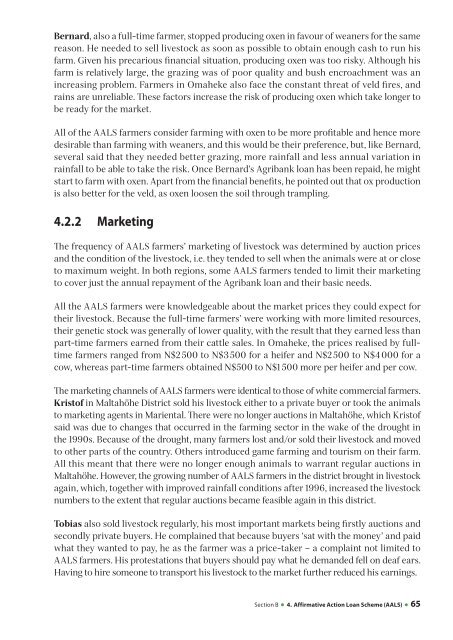Namibia country report
Namibia country report
Namibia country report
- No tags were found...
Create successful ePaper yourself
Turn your PDF publications into a flip-book with our unique Google optimized e-Paper software.
Bernard, also a full-time farmer, stopped producing oxen in favour of weaners for the samereason. He needed to sell livestock as soon as possible to obtain enough cash to run hisfarm. Given his precarious financial situation, producing oxen was too risky. Although hisfarm is relatively large, the grazing was of poor quality and bush encroachment was anincreasing problem. Farmers in Omaheke also face the constant threat of veld fires, andrains are unreliable. These factors increase the risk of producing oxen which take longer tobe ready for the market.All of the AALS farmers consider farming with oxen to be more profitable and hence moredesirable than farming with weaners, and this would be their preference, but, like Bernard,several said that they needed better grazing, more rainfall and less annual variation inrainfall to be able to take the risk. Once Bernard’s Agribank loan has been repaid, he mightstart to farm with oxen. Apart from the financial benefits, he pointed out that ox productionis also better for the veld, as oxen loosen the soil through trampling.4.2.2 MarketingThe frequency of AALS farmers’ marketing of livestock was determined by auction pricesand the condition of the livestock, i.e. they tended to sell when the animals were at or closeto maximum weight. In both regions, some AALS farmers tended to limit their marketingto cover just the annual repayment of the Agribank loan and their basic needs.All the AALS farmers were knowledgeable about the market prices they could expect fortheir livestock. Because the full-time farmers’ were working with more limited resources,their genetic stock was generally of lower quality, with the result that they earned less thanpart-time farmers earned from their cattle sales. In Omaheke, the prices realised by fulltimefarmers ranged from N$2 500 to N$3 500 for a heifer and N$2 500 to N$4 000 for acow, whereas part-time farmers obtained N$500 to N$1 500 more per heifer and per cow.The marketing channels of AALS farmers were identical to those of white commercial farmers.Kristof in Maltahöhe District sold his livestock either to a private buyer or took the animalsto marketing agents in Mariental. There were no longer auctions in Maltahöhe, which Kristofsaid was due to changes that occurred in the farming sector in the wake of the drought inthe 1990s. Because of the drought, many farmers lost and/or sold their livestock and movedto other parts of the <strong>country</strong>. Others introduced game farming and tourism on their farm.All this meant that there were no longer enough animals to warrant regular auctions inMaltahöhe. However, the growing number of AALS farmers in the district brought in livestockagain, which, together with improved rainfall conditions after 1996, increased the livestocknumbers to the extent that regular auctions became feasible again in this district.Tobias also sold livestock regularly, his most important markets being firstly auctions andsecondly private buyers. He complained that because buyers ‘sat with the money’ and paidwhat they wanted to pay, he as the farmer was a price-taker – a complaint not limited toAALS farmers. His protestations that buyers should pay what he demanded fell on deaf ears.Having to hire someone to transport his livestock to the market further reduced his earnings.Livelihoods Section after B ● 4. Land Affirmative Reform: <strong>Namibia</strong> Action Loan <strong>country</strong> Scheme <strong>report</strong> (AALS) (2010) ● 65
















